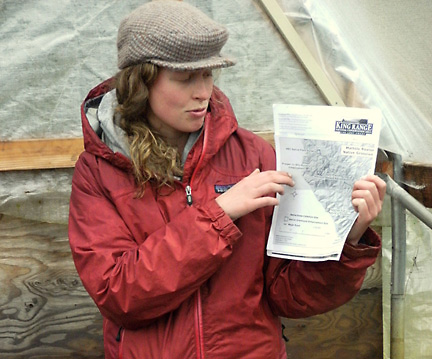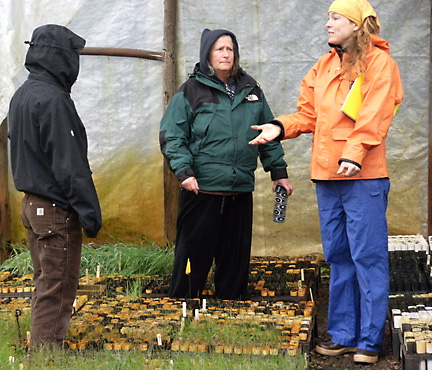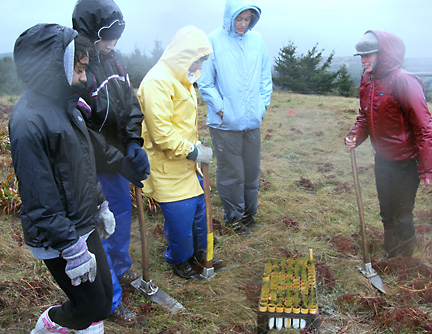| Bunch Grasses Protect Soil
and Build Community in Northern California
|
 |
By Amanda Barker |
March 2010 |
Eighteen volunteers arrived at the Mattole Restoration Council (MRC) Native Plant Nursery in Petrolia, California on a Tuesday in February 2010 to assist Americorps Watershed Stewards Project (WSP) members Nora Talkington and her site partner Vimal Golding plant bunch grass plugs on Prosper Ridge. Rain fell from the silver sky, but “never doubt that a small group of thoughtful, committed citizens can change the world,” suggested anthropologist Margaret Mead, despite any adversity or any obstacle.
Despite strong winds and heavy rain, over 300 plugs of native grasses were planted on Prosper Ridge in Petrolia that day. Situated within the King Range of Humboldt County, Petrolia is a town of approximately 500 people. Solitude enhances its natural beauty, and with only one road to travel from Highway 101, it remains a distant gem glittering among the coastal Redwood forest.
(Left) Nora Talkington of the Watershed Stewards Project describes the location of Prosper Ridge on a map of the King Range to volunteers.
The one road into Petrolia, appropriately named “The Wildcat,” is steep and narrow, winding severely through backcountry forest. Laced with deep, intermittent potholes, the 36 mile jaunt from the highway feels more like a pilgrimage, as any wise motorist will avoid speeds beyond even 15 miles an hour. Herds of loose, roaming cattle meander between unfenced pastures, hardly moving for any solitary vehicle traveling through. Petrolia is found in wild country, and as Thoreau acclaimed, “in wilderness is the preservation of the world.” Talkington and her site partner Golding had coordinated this planting to fulfill their Individual Service Project requirement with the WSP. The WSP, a special project of the California Conservation Corps, enrolls members through Americorps. Golding, Talkington, and 42 other colleagues must fulfill their community service requirements before the end of November 2010, to complete their term.
Talkington collaborated with Monica Scholey, the MRC Native Plant Nursery Manager and WSP alumna, to facilitate this project. “Our project gave community members the chance to learn about various native grasses in the Mattole Valley and to take an active role in enhancing grassland diversity on Prosper Ridge,” says Talkington.
Monica Scholey (right), Watershed Stewards Project alum and Mattole Restoration Council Native Plant Nursery Manager, discusses the riparian benfits of bunch grass with two volunteers in the MRC greenhouse before heading to Prosper Ridge to plug grass.
Scholey welcomed the volunteers with a tour of the Native Plant Nursery in Petrolia. She told them about the species of bunch grasses that are collected in the spring and summer to be replanted in riparian areas in need of erosion and landslide stabilization. After the tour and a brief lesson in transplanting, Talkington guided a carpool to Prosper Ridge. Prosper Ridge is an ‘in situ’ native plant nursery in the hills overlooking the Pacific Ocean, managed through the Bureau of Land Management Arcata Field Office. The newly planted plugs will assist with erosion control and other types of riparian dysfunction. “Grassland habitat in the Mattole Valley has decreased significantly over the past 50 years due to conifer encroachment from fire suppression,” explains Talkington. “Additionally, many invasive annual grasses tend to have more shallow roots than native perennial grasses, making them less able to stabilize soils.” The deep roots of the bunch grasses hold them in the soil, protecting the grassland habitat from erosion and landslides. Since some species of bunch grasses can live over 100 years, they also provide a long-term and consistent source of food for grazing animals. Talkington, Golding, and the volunteers planted six different species of bunch grass; California oatgrass, Idaho fescue, Junegrass, tufted hairgrass, leafy reed grass, and California oniongrass. Leafy reed grass is endemic to the Northern California coast, and can be found only in Mendocino, Humboldt, and Del Norte Counties.
Nora Talkington of the WSP (above right, in red) demonstrates bunch grass plugging to a group of high school volunteers from Marin Academy on Prosper Ridge. Talkington will continue her work with the Mattole Restoration Council until the end of her WSP term in November 2010. For more information about the Watershed Stewards Project, please visit us on the web at www.watershedstewards.org. To receive a free, monthly copy of the volunteer newsletter with updates about upcoming volunteer opportunities, please email wsp.vmtl@ccc.ca.gov with “Water Ways” in the subject line.
Amanda Barker is an Americorps volunteer in the Media Team Leader position with the Watershed Stewards Project in Fortuna, Californa. She completed her Bachelor of Arts in Communication and Culture from Indiana University, and her Master of Arts in Social Sciences from Humboldt State University. She can be contacted via email at: wsp.vmtl.@ccc.ca.gov.
|
|


